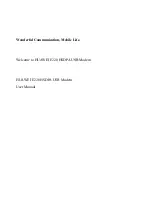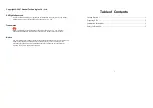
11
Raveon Technologies Corp.
The transmit audio input pin 1 is designed to have audio sent in with a 1.66 V DC bias.
If the audio input has a different DC bias voltage, the M8 can be reconfigured to use
the different DC bias offset. The
AFDC
sets the nominal DC bias voltage. Note, the
analog input range of the M8S is 0-3.3V. Ideally bias the DC input to 1.66V or AC
couple it with a capacitor and add two bias resistor to ground and 3.3V. One hundred
counts (or 100mV) will shift the frequency about .7kHz, use caution with this command.
To have the M8 determine the DC bias input automatically and use the measured DC
level as the DC input, set
AFDC
to 0 to have the M8 automatically find the DC input
bias and compensate for it.
The
AFLVL
command sets the DC gain of the TX audio input. With it set to 100%, an
audio signal with a peak-to-peak value of 500mV will p/- 2kHz of FM deviation.
With
AFLVL
set to 200, 250mV p-p input will give 2kHz p-p of FM deviation.
The
AFLIM
command sets a hard FM deviation limit, which will stop the M8 from
deviating the FM carrier beyond the preset limit when the input TX audio exceeds a
threshold that would cause the M8 to over-deviate.
Raveon suggests the
AFDC
,
AFLVL
, and
AFLIM
always be adjusted and calibrated by
trained radio technicians familiar with setting FM deviation gain and FM limiters.
The
TXTOT
command sets the transmit time-out-timer (TOT). The TOT protects the
radio and the system from damage and interference due to accidental over-keying of a
transmitter. Set the
TXTOT
value to the maximum number of seconds a TX audio
pass-through transmission should ever take. If the
TXTOT
times-out, the M8 will
automatically un-key, and not re-key again until the PTT line is negated, and then
some time re-asserted.
Typically, the audio output with a 2kHz FM deviation, will have a peak to peak of
300mV - 400mV and a DC offset around 500-1000mV. If you circuit does not
accommodate DC offset be sure to add a coupling capacitor.
3.3. USB [ U ] 5T837
The USB works as a serial to USB converter. This requires a FTDI USB driver. This
should automatically install to your computer when the radio is plugged in, if not,
please download the driver from the Raveon website.
3.4. RS-485
[ T ] 5T836-1
RS-485 is two-wire connection, with the pair of wires transmitting and receiving data.







































